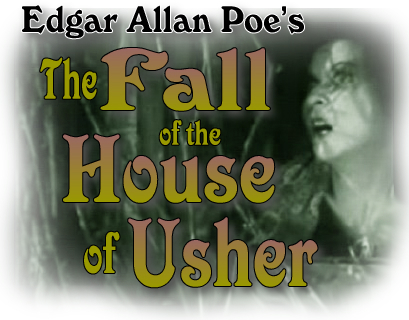

Outline of Edgar Allan Poe's Novel
1. A day's ride through desolate countryside brings a horseman
to the melancholy House of Usher.
2. He reflects on his growing despair as he sees the neglected
house, and then sees it reflected in the black waters of the tarn.
3. He reflects on his boyhood friend, Roderick Usher, not seen
for many years but now begging him to come for awhile to counteract
his growing madness.
4. He notices a fissure in the tarn side wall of the house as
he rides in. A servant takes his horse.
5. A valet leads him on the long and half-remembered walk, passing
en route the family physician of sinister aspect, ultimately reaching
the vast room where Usher gets up from lying on a sofa to greet
him. The room has large parts in darkness and only dim light coming
in from the narrow and very high windows.
6. Recalling his friend's features, he is appalled by the ghastly
pallor of his skin and the incoherence of his speech. He was alternatingly
vivacious and sullen while explaining his malady which included
a morbid acuteness of the senses, so that most music and even
weak lights savaged his senses.
7. Terror has grown within him, his friend said, including oppressive
superstitious fears that his invalid sister, his only relative
on earth, would die from her long illness. She walked slowly into
the 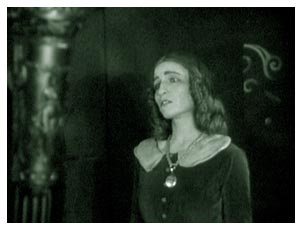 room and away through another door
in the darkest part, taking no notice of her brother or his friend.
room and away through another door
in the darkest part, taking no notice of her brother or his friend.
8. The two friends pass their time reading and painting together,
with Usher, the hypochondriac, claiming his disorder is partly
due to some gradual sentience gathered over generations in the
House which had moulded the destinies of his family.
9. Detail is given of the abstract art and the books discussed,
including Usher's occasional ballads such as the six eight-line
stanzas of "The Haunted Palace" which concluded . .
.
10. The fervid facility of his wild performances with these
rhymed fantasies and his artificial excitement foreshadowed the
tottering of his lofty reason upon her throne.
11. Usher suddenly tells his friend that his sister has died,
and he wants his help to place her body in a vault before the
funeral.
12. They carry the coffin to a deep vault, years previously a
dungeon, and after an awed glance at Usher's twin sister, they
screw down the coffin lid.
13. After a few days of bitter grief, Usher's manner changes to
aimless wandering about the House or staring fixedly into space,
his voice deteriorating to a tremulous quaver.
14. Then comes a tempest and whirlwind, the sleepless friend meeting
Usher on the stairs and throwing open a window. A visible gaseous
exhalation enshrouds the House. Sounds within the House are heard,
clangorous, but apparently muffled. His friend reads from a book
to calm his nerves, but the text being read emphasized these noises.
15. Usher talks in a hurried and gibbering murmur. "Yes,
I hear it - have heard it long - long - days - I dared not speak
- we have put her living in the tomb." He springs to his
feet. "Madman - I tell you she now stands by the door."
A rushing gust of the whirlwind forces the door, and there stands
the enshrouded figure of the lady Madeleine of Usher with blood
upon her white robes. Then, with a low moaning cry, she falls
heavily upon the person of her brother and bears him to the floor
a corpse, a victim to the terrors he had anticipated.
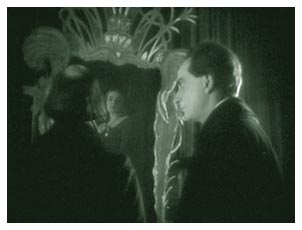 16. From the House the friend flees aghast.
On the causeway, blood red moonlight shines through the fissure
which widens rapidly, the mighty walls rushing asunder as the
tarn at his feet closes sullenly and silently over the fragments
of the House of Usher.
16. From the House the friend flees aghast.
On the causeway, blood red moonlight shines through the fissure
which widens rapidly, the mighty walls rushing asunder as the
tarn at his feet closes sullenly and silently over the fragments
of the House of Usher.
Treatment of the Film
Filmic action is positively described only parts 1, 4, 5, 7, 12,
14, 15, 16 and occupies only about 800 words of the original text
of the 7,500 word novel - say 10 percent. So, anyone deciding
to film it will have to add a lot of action or decide to undertake
filmic interpretations of thoughts and feelings.
When the director Jean Epstein tackled the job in 1928, he clearly decided to increase the cast and apply top quality setting, adding the gist of another Edgar Allan Poe story, "The Oval Portrait." So, it is not really a film of the original story, but a largely independent work. I think a simple running filmic commentary will be the best way to show all its good points without unnecessary reference to the missing factors.
The 1928 French film by Jean Epstein, 1271 metres = 4,170 feet = 46 minutes at 24 fps as recorded by Cinematheque Belge who restored it in 1997. I had almost finished this commentary when, at last, I found that a complete version of Epstein's film had been released with sound in the USA in 1929 at the original speed of 24 fps and running for 66 minutes with all the original French titles intact. Despite weaknesses, it has valid claims to be a truly great film, as I hope this commentary will indicate.
The Story
Traveler with two Gladstone bags trudges over marshy field. Bare,
wintry trees. Gloved hands rubbing for warmth. A rustic sign,
"Usher," lies where it fell. More trudging. A door latch
lifted. Three men playing cards all stare at traveler. He reads
his route with a magnifying glass, fussily cleaning it and his
ear trumpet and asks to be driven to the House of Usher. Titles:
"Usher?!" then "Usher??!!" confirm mysterious
doubts. Then one man accepts quietly - "Usher" - and
takes the bag of money offered. A woman listens in dread . . .
and watches from windows as they depart.
Title: "Usher." The menacing ruin where Sir Roderick Usher keeps in strange reclusion his wife, Madeleine, overpowered by nervous stresses. In L.S., at the far end of a large room, Madeleine emerges from a dark recess. In closer shots, intercut with C.M.S. of Usher, she approaches and takes up a model position near a vaguely-seen portrait while he watches and prepares his pallet. Then in C.S., he adds a touch to the painting - and she soothes the effect on her cheek (as described in Poe's story "The Oval Portrait").
This huge room is the main interior setting of the film
and gets many notable but variable additions, as required, and
all adding to the dream-like quality where sizes and continuity
are often lost 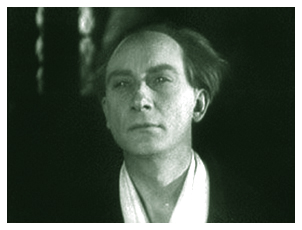 or confused. Here, the long wall
to the left of the room consists entirely of ceiling-high, plain,
dark curtains reaching to the stone floor and largely concealing
their supporting pillars. They give directly to the wild garden,
whence dead leaves enter the room. The end wall of the room sometimes
includes the portrait of Madeleine - and sometimes herself, posing
and in different frames. The wall to the right is seen only at
the far end where it sometimes emerges from darkness to show a
curved stairway of large stone steps. Items like a table, formally
laid for two, or a huge armchair appear as needed. No questions
asked - just as in a dream.
or confused. Here, the long wall
to the left of the room consists entirely of ceiling-high, plain,
dark curtains reaching to the stone floor and largely concealing
their supporting pillars. They give directly to the wild garden,
whence dead leaves enter the room. The end wall of the room sometimes
includes the portrait of Madeleine - and sometimes herself, posing
and in different frames. The wall to the right is seen only at
the far end where it sometimes emerges from darkness to show a
curved stairway of large stone steps. Items like a table, formally
laid for two, or a huge armchair appear as needed. No questions
asked - just as in a dream.
Usher greets his friend warmly on a small exterior terrace, and they enter the huge room following a footman with the two bags. They are in C.M.S. near a wall panel inscribed in white - "Ligeia/Lady Usher/1717" - and they meet the house physician, a man of pompous and sinister aspect who says, "The illness of Lady Madeleine baffles medical science." The three men converse vaguely and in C.M.S. with the portrait, the physician says of it, "It is there that she is alive."
The physician departs. Cold wind sways the line of long
dark curtains, and on the stone floor a few leaves drift about.
There is no outside wall. Seen in a gap, books fall into the floor.
The friend shivers and tightens his jacket. Amid many glasses
and candles and two small decanters on a laid table, the two sit
down. The butler enters and says,
"Her Grace is feeling tired and begs you to excuse her from
the table." The butler serves lunch to friend. Usher starts
playing his guitar, walking with it. Repeated C.S. of fingers
playing are intercut with his close-ups. Then, we see exteriors
with bare trees and a stretch of calm water and two sets of three
short shots, different water surfaces.
Usher stops playing the guitar, and, in two tracking close-ups, he goes right up to the portrait, discards the guitar - and in two close tracking shots, seizes his pallet. A title states, "A curious hereditary flaw makes the Ushers addicted to painting portraits of their wives."
They walk up to the portrait, and Usher says, "Truly she is alive." His friend compliments the portrait but is feeling the cold. L.S. of curtains swaying. Lengthy exterior pan shot with wind details. M.S. shows Usher and friend battered by books and papers dislodged by the wind. The friend continues to be anxious, so Usher tells him to worry more about himself and go out for fresh air. He goes reluctantly and hesitates on the outdoor steps, but Usher emerges with a heavy coat and scarf and sees him off. Then in M.S., Usher picks up his pallet again, and in a tracking shot with his head and shoulders held in close-up, he walks briskly back to the portrait.
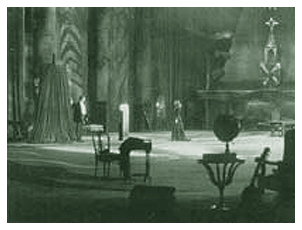 His friend wanders in sight of
the mansion which seems disconcertingly light but strange (model
sufficiently detailed). He sees a dog and calls for it, but it
turns tail and runs away.
His friend wanders in sight of
the mansion which seems disconcertingly light but strange (model
sufficiently detailed). He sees a dog and calls for it, but it
turns tail and runs away.
In close-up tracking shot, Usher approaches and grabs a circular pallet and brushes, and in tracking C.M.S., he goes up to the portrait. Madeleine walks in, and a title repeats the "Oval Portrait" theme. Close-ups show her very pale, and in full L.S., she returns and collapses into the armchair. Usher kneels by her and clasps her hands.
She slowly recovers, and Usher resumes painting fiercely. Strong illumination glows from about 25 candles all touching in a rough square. In many staring close-ups - progressively closer - Usher looks unhinged, and quick cutting of pallet, brushes, staring eyes and the portrait are intercut with balancing close-ups of Madeleine drooping sadly as she "loses flesh to the portrait." This complex montage is highly effective but ends slightly overcharged with several double and treble-exposed close ups of Madeleine.
Next we see exterior shots of the friend pulling the bell rope and of the large roof bell, as he tries to get in - and one ground level exterior M.S. of worried butler. The friend enters. Madeleine collapses in three slow-motion shots, swaying till she crumples on the floor. Then Usher carries away the unconscious Madeleine.
Her body reposes in bed, Usher kneeling beside. He is studying a book about magnetism and mortality, connected with Poe's "Ligeia" story about revival after death. He gets up and trots downstairs as the physician arrives with the coffin and coffin-maker who carries a crude hammer with a square head. In M. shots and C.M.S., Usher argues fiercely with the physician that she is not dead, and the friend tries to calm him. Soon, she is in the coffin, and its lid slides shut over her face. He stops the nailing of the lid and exclaims, "She will not leave me. We will bury her here." The four men take the corners of the coffin, from which a long train of white muslin trails as they lift it and walk from the house.
Exterior, full long shot: The four are walking towards the camera, coming over the brow of a hill into an avenue of superimposed lofty candles, eight or nine each side and all lit. The four men are decidedly jogging up and down emphasised in close shots of them each with adjacent candles. Brief shots of stark trees are shown, also filmed with jogging camera. Then, walking resumes, white train mistily following. They come to the bottom of a long, curved line of many wide stone steps, and the coffin man starts hammering in nails, watched by the physician who nods in time with the blows of the hammer. There is much intercut detail, including trick doubled close-ups of nails being hammered in - also, excessive and obscure details of plants and mating frogs in and around the vault or cave (not established) where the coffin is left. Then, with his friend's support, Usher ascends the steps followed by the others, and they emerge into the wood crowded with dark, bare trees.
Continuity title. "After the burial of Madeleine, the hours, the days, passed away in frightening silence and monotony."
L.S. of deserted room with deserted guitar. Usher, inanimate,
but with hands clenched in full C.S. Friend with magnifier, reading.
M.S. of long case striking clock. A strange and grossly magnified
shot of one swing of a pendulum bob. Continuity title explains,
"Usher's nerves are so stressed that the slightest noise
torments him." Then . . .
1. L.S. room, Usher in dark corner
2. C.S. his guitar
3. C.S his clenched fingers
4. C.S. his guitar
5. C.M.S. Usher staring.
6. C.S. his friend's hand with magnifying glass.
7. C.M.S. friend reading large tome on a stand
8. C.S. Second hand of clock ticks two seconds
9. C.M.S. as 5
10. C.S. his guitar, closer
11. C.S. as 3
12. M.S. Another swing of the huge pendulum bob
13. C.S. as 8
14. M.S. the long case striking clock
15. C.S. detail of striking mechanism
16. C.S. clock bell hit by striker
17. L.S. as 1, but superimposed on an unsteady copy
18. C.S. Usher staring, looks round at
19. C.S. as 16
20. C.S. as 4, but superimposed on an unsteady copy
21. C.S. Usher, hands tremble
The pairs of shots are repeated until a final repeated pair of guitar close-ups, each with a string breaking. Then two shots of the huge room and the guitar, each superimposed on exactly the same shot but taken with the camera slightly displaced, and unsteady, illustrating Usher's mental upset from noise.
Usher walks slowly and nervously away, close-ups showing his hands gripping, then wavering. His friend with a magnifier is still deeply engaged in a large tome. Usher is near the portrait, and a C.S. of his staring eyes brings a title: "He dare not repeat his mad thoughts that they had entombed the living Madeleine."
The empty hours still drift, now shown with a different
style. Key subject filmed with back light only, black foreground
and black beyond, brilliant thin white outline of subject. A cat
wanders in. The friend slowly shuts book. Pages, a few at a time,
then the cover, drop back in place - big close-up. The friend
shivers, walks way, curtains billowing again. Then with camera
close to the stone 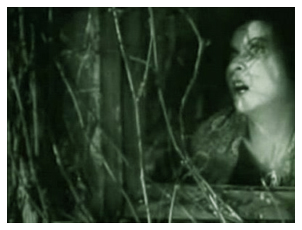 floor, there are
two fast travelling shots up to and beyond the curtains and a
wide panning shot - all collecting and dispersing leaves.
floor, there are
two fast travelling shots up to and beyond the curtains and a
wide panning shot - all collecting and dispersing leaves.
Title: "The stormy night seemed to be charged with electricity." Exterior - cascades of lights and vapours pour from the sky.
As the friend watches near a casement window, it bursts open. He looks out, full of unease. The House bell tolls. In M.S., Usher is coming, carrying three candles. In full C.S., he says, eye gleaming, "Now can you hear?" He joins his friend, and they crouch close together looking out of the window from which brilliant flashes of light appear. The combined full close-up is alternately dark and lit up by storm flashes. They are looking at a general exterior view of the house, now bedecked with many white lights and cloaked with the swirling mists or fogs. The shots of the house are intercut five times with the close-up of the interested pair, and twice it includes an oval white icon which defies description. Then, led by his friend, the pair cross the room, and his friend says there are things he must not see - and he will read to him as a distraction.
So in C.M.S., seated in a massive chair and with magnifier, he starts reading from an antique volume - the "Mad Trist" (ascribed in the book to a titled author but actually all written by E.A. Poe). There are three quoted passages, each shown as a part of a book page in three lengthy titles and occupying a total of 52 seconds of screen time (which seriously slows the tempo of the concurrent action). They are intercut with the friend's quite jaunty reading with rhythmic gestures of his magnifying glass seeming to beat time - and Usher rather detached. Down in the vault, the coffin falls to the ground, and the muslin trail starts to emerge from a crack.
As the friend's reading ends, Usher leans back in his chair, swinging a leg as mists swirl round him. A fluttering candle shows increasing wind, and books fall down beside an armed warrior statue. Close-ups confirm the relaxed Usher, but a gust blows the pages into his friend's face, and the hefty statue of the warrior crashes heavily to the floor in semi-slow motion. General exterior shots, including the house model festooned with lights, continue with vivid flashes of light and some fiery particles dropping.
Then, in L.S. presented at screen centre and reduced by black framing, Madeleine walks away from the coffin and struggles to free her head and shoulders from the muslin veil. The friend makes gestures of amazement and horror, but Usher says, "Yes - I heard - and have heard. . ." The friend strides up to Usher and shouts, "We have put her living in the tomb."
Madeleine enters the house through the billowing curtains in a shot held to emphasise her waist-length vivid black hair (surely another nod to Ligeia). In L.S., she joins Usher and his over-excited friend in a set piece interior with flames around them at floor level. There are fires on the stairway. Usher supports Madeleine and almost carries her as they walk out. In large C.S., the portrait frame is shown to be empty but leaping flames appears in it. The three again walk across the room, intercut with exterior shots of fire at the model, and then comes an uncertain M.S. of a white egg-like object at frame centre. Then back to the trio together in L.S. Fade out. FIN.
H.A.V. Bulleid April 19, 2009.